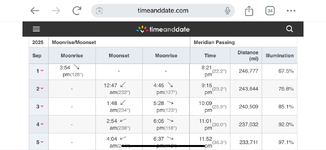GunsAreFun
WKR
- Joined
- Apr 18, 2019
- Messages
- 1,910
I’ve tried google and AI lol and can’t get a clear understanding to my question about meridian passing.
So, on September 1 at this particular location, the moons meridian passing is at 8:21pm and 22.2°. Does this mean that at its highest point for the night, the moon is only 22.2° above the horizon?

So, on September 1 at this particular location, the moons meridian passing is at 8:21pm and 22.2°. Does this mean that at its highest point for the night, the moon is only 22.2° above the horizon?

